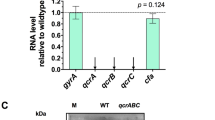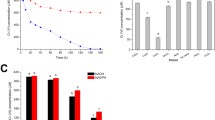Abstract
Copper is both an essential nutrient and a toxic element able to catalyze free radicals formation which damage lipids and proteins. Although the available copper redox species in aerobic environment is Cu(II), proteins that participate in metal homeostasis use Cu(I). With isolated Escherichia coli membranes, we have previously shown that electron flow through the respiratory chain promotes cupric ions reduction by NADH dehydrogenase-2 and quinones. Here, we determined Cu(II)-reductase activity by whole cells using strains deficient in these respiratory chain components. Measurements were done by the appearance of Cu(I) in the supernatants of cells exposed to sub-lethal Cu(II) concentrations. In the absence of quinones, the Cu(II)-reduction rate decreased ~70% in respect to the wild-type strain, while this diminution was about 85% in a strain lacking both NDH-2 and quinones. The decrease was ~10% in the absence of only NDH-2. In addition, we observed that quinone deficient strains failed to grow in media containing either excess or deficiency of copper, as we have described for NDH-2 deficient mutants. Thus, the Cu(II)-reduction by E. coli intact cells is mainly due to quinones and to a lesser extent to NDH-2, in a quinone-independent way. To our knowledge, this is the first in vivo demonstration of the involvement of E. coli respiratory components in the Cu(II)-reductase activity which contributes to the metal homeostasis.




Similar content being viewed by others
References
Albarracín VH, Ávila AL, Amoroso MJ, Abate CM (2008) Copper removal ability by Streptomyces strains with dissimilar growth patterns and endowed with cupric reductase activity. FEMS Microbiol Lett 288:141–148
Anraku Y, Gennis RB (1987) The aerobic respiratory chain of Escherichia coli. Trends Biochem Sci 12:262–266
Bagai I, Rensing C, Blackburn NJ, McEvoy MM (2008) Direct metal transfer between periplasmic proteins identifies a bacterial copper chaperone. Biochemistry 47:11408–11414
Benov L, Chang LY, Day B, Fridovich I (1995) Copper, zinc superoxide dismutase in Escherichia coli: periplasmic localization. Arch Biochem Biophys 319:508–511
Calhoun MW, Gennis RB (1993) Demonstration of separate genetic loci encoding distinct membrane-bound respiratory NADH dehydrogenases in Escherichia coli. J Bacteriol 175:3013–3019
Carmel-Harel O, Storz G (2000) Roles of glutathione- and thioredoxindependent reduction systems in the Escherichia coli and Saccharomyces cerevisiae response to oxidative stress. Ann Rev Microbiol 54:439–461
Chillappagari S, Seubert A, Trip H, Kuipers OP, Marahiel MA, Miethke M (2010) Copper stress affects iron homeostasis by destabilizing iron-sulfur cluster formation in Bacillus subtilis. J Bacteriol 192:2512–2524
Dawson RMC, Elliott DC, Elliott WH, Jones KM (1986) Data for Biochemical Research, 3rd edn. Oxford Science Publications, Oxford University Press, NY
Fan B, Rosen BP (2002) Biochemical characterization of CopA, the Escherichia coli Cu(I)-translocating P-type ATPase. J Biol Chem 277:46987–46992
Futarni AE, Hunt E, Hanska GG (1979) Vectorial redox reactions of physiological quinones, requirement of a minimum length of the isoprenoid side chain. Biochim Biophys Acta 547:583–596
Georgatsou E, Mavrogiannis LA, Fragiadakis GS, Alexandraki D (1997) The yeast Fre1p/Fre2p cupric reductases facilitate copper uptake and are regulated by the copper-modulated Mac1p activator. J Biol Chem 272:13786–13792
Grabbe R, Schmitz R (2003) Oxygen control of nif gene expression in Klebsiella pneumoniae depends on NifL reduction at the cytoplasmic membrane by electrons derived from the reduced quinone pool. Eur J Biochem 270:1555–1566
Gutteridge JM, Halliwell B (2000) Free radicals and antioxidants in the year 2000. A historical look to the future. Ann N Y Acad Sci 899:136–147
Hackenbrock CR (1981) Lateral diffusion and electron transfer in the mitochondrial inner membrane. Trends Biochem Sci 6:151–154
Hassett R, Kosman DJ (1995) Evidence for Cu(II) reduction as a component of copper uptake by Saccharomyces cerevisiae. J Biol Chem 270:128–134
Helbig K, Bleuel C, Krauss GJ, Nies DH (2008) Glutathione and transition-metal homeostasis in Escherichia coli. J Bacteriol 190:5431–5438
Ingledew WJ, Poole RK (1984) The respiratory chains of Escherichia coli. Microbiol Rev 48:222–271
Kershaw CJ, Brown NL, Constantinidou C, Patel MD, Hobman JL (2005) The expression profile of Escherichia coli K-12 in response to minimal, optimal and excess copper concentrations. Microbiology 151:1187–1198
Kingsley GB, Getehell O (1956) Serum iron determination. Clin Chem 2:175–183
Korshunov S, Imlay JA (2006) Detection and quantification of superoxide formed within the periplasm of Escherichia coli. J Bacteriol 188:6326–6334
Linder MC (1991) Biochemistry of copper. Plenum, New York
Lowry OH, Rosebrough NJ, Farr AL, Randal RJ (1951) Protein measurement with the Folin phenol reagent. J Biol Chem 193:265–275
Macomber L, Rensing C, Imlay JA (2007) Intracellular copper does not catalyze the formation of oxidative DNA damage in Escherichia coli. J Bacteriol 189:1616–1626
Miller S, Douglas RM, Carter P, Booth IR (1997) Mutations in the glutathione-gated KefC K+ efflux system of Escherichia coli that cause constitutive activation. J Biol Chem 272:24942–24947
Minagawa J, Mogi T, Gennis RB, Anraku Y (1992) Identification of heme and copper ligands in subunit I of the cytochrome bo complex in Escherichia coli. J Biol Chem 267:2096–2104
Outten FW, Outten CE, Hale J, O’Halloran TV (2000) Transcriptional activation of an Escherichia coli copper efflux regulon by the chromosomal MerR homologue, cueR. J Biol Chem 275:31024–31029
Petersen C, Moller LB (2000) Control of copper homeostasis in Escherichia coli by a P-type ATPase, CopA, and a MerR-like transcriptional activator, CopR. Gene 261:289–298
Poillon WN, Dawson CR (1963) On the nature of copper in ascorbate oxidase: the valence state of copper in the denatured and native enzyme. Biochim Biophys Acta 77:27–36
Puustinen A, Finel M, Haltia T, Gennis RB, Wikström M (1991) Properties of the two terminal oxidases of Escherichia coli. Biochemistry 30:3936–3942
Rapisarda VA, Rodríguez-Montelongo L, Farías RN, Massa EM (1999) Characterization of an NADH-linked cupric reductase activity from the Escherichia coli respiratory chain. Arch Biochem Biophys 370:143–150
Rensing C, Grass G (2003) Escherichia coli mechanisms of copper homeostasis in a changing environment. FEMS Microbiol Rev 27:197–213
Rensing C, Fan B, Sharma R, Mitra B, Rosen BP (2000) CopA: an Escherichia coli Cu(I)-translocating P-type ATPase. Proc Natl Acad Sci USA 97:652–656
Rezaïki L, Lamberet G, Derré A, Gruss A, Gaudu P (2008) Lactococcus lactis produces short-chain quinones that cross-feed Group B Streptococcus to activate respiration growth. Mol Microbiol 67:947–957
Ridge PG, Zhang Y, Gladyshev VN (2008) Comparative genomic analyses of copper transporters and cuproproteomes reveal evolutionary dynamics of copper utilization and its link to oxygen. PLoS ONE 3:e1378
Rodríguez-Montelongo L, Farías RN, Massa EM (1995) Sites of electron transfer to membrane-bound copper and hydroperoxide-induced damage in the respiratory chain of Escherichia coli. Arch Biochem Biophys 323:19–26
Rodríguez-Montelongo L, Volentini SI, Farías RN, Massa EM, Rapisarda VA (2006) The Cu(II)-reductase NADH dehydrogenase-2 of Escherichia coli improves the bacterial growth in extreme copper concentrations and increases the resistance to the damage caused by copper and hydroperoxide. Arch Biochem Biophys 451:1–7
Singh SK, Grass G, Rensing C, Montfort WR (2004) Cuprous oxidase activity of CueO from Escherichia coli. J Bacteriol 186:7815–7817
Solioz M, Stoyanov JV (2003) Copper homeostasis in Enterococcus hirae. FEMS Microbiol Rev 27:183–195
Stoyanov JV, Hobman JL, Brown NL (2001) CueR (YbbI) of Escherichia coli is a MerR family regulator controlling expression of the copper exporter CopA. Mol Microbiol 39:502–511
Thiele DJ (2003) Integrating trace element metabolism from the cell to the whole organism. J Nutr 133:1579S–1580S
Volentini SI, Schurig-Briccio LA, Rintoul MR, Farías RN, Rodríguez-Montelongo L, Rapisarda VA (2008) Cellular Cu(II)-reduction by Escherichia coli respiratory chain in copper exporters deficient strains. Abstract in: Biocell Suppl 32:117. ISSN 0327–9545
Vulpe CD, Packman S (1995) Cellular copper transport. Ann Rev Nutr 15:293–322
Wallace BJ, Young IG (1977a) Aerobic respiration in mutants of Escherichia coli accumulating quinone analogues of ubiquinone. Biochim Biophys Acta 461:75–83
Wallace BJ, Young IG (1977b) Role of quinones in electron transport to oxygen and nitrate in Escherichia coli: studies with ubiA − and menA − double quinone mutant. Biochim Biophys Acta 461:84–100
Yamamoto K, Ishihama A (2005) Transcriptional response of Escherichia coli to external copper. Mol Microbiol 56:215–227
Acknowledgments
We specially thank Dr E. M. Massa, who has been the mentor of our investigations in the subject, and the lab colleagues M. R. Rintoul, L. A. Schurig-Briccio, J. M. Villegas and L. Cerioni for helpful discussions. We also thank Dr B. J. Wallace for providing strains AN387, Dr R. A. Schmitz for strain RAS50, Dr C. Rensing for strain GR6, Dr J. Imlay for providing strains SSK1, SSK2 and SSK3 and Dr I. R. Booth for providing strain MJF335. This research was supported by grants from CIUNT, CONICET, and ANPCyT (Argentine).
Author information
Authors and Affiliations
Corresponding author
Rights and permissions
About this article
Cite this article
Volentini, S.I., Farías, R.N., Rodríguez-Montelongo, L. et al. Cu(II)-reduction by Escherichia coli cells is dependent on respiratory chain components. Biometals 24, 827–835 (2011). https://doi.org/10.1007/s10534-011-9436-3
Received:
Accepted:
Published:
Issue Date:
DOI: https://doi.org/10.1007/s10534-011-9436-3




